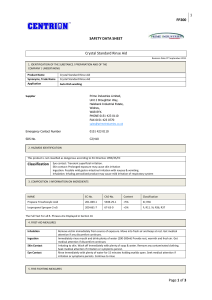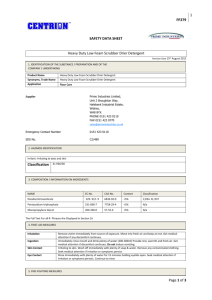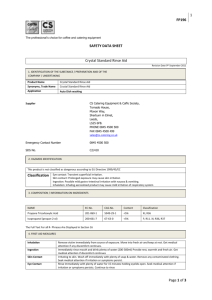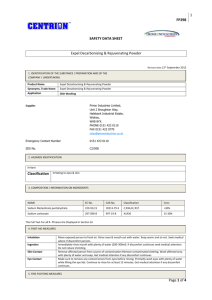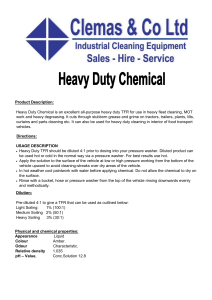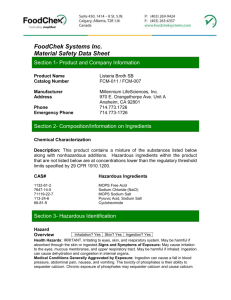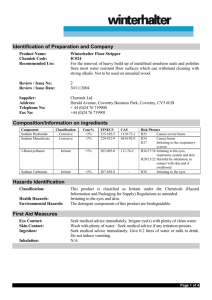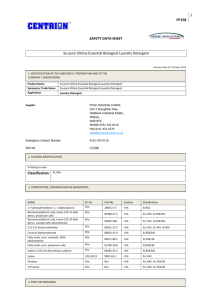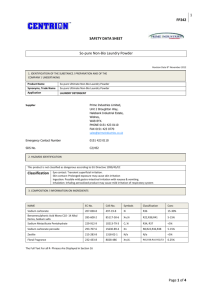FP256 - Yorkshire Hygiene Supplies
advertisement
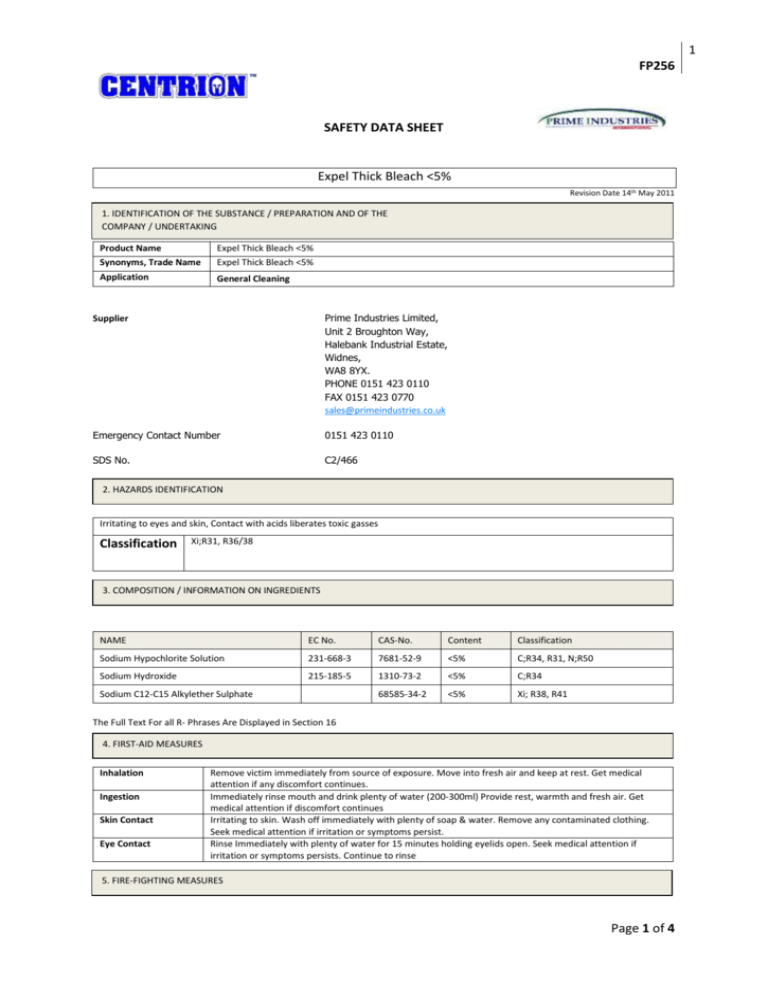
1 FP256 SAFETY DATA SHEET Expel Thick Bleach <5% Revision Date 14th May 2011 1. IDENTIFICATION OF THE SUBSTANCE / PREPARATION AND OF THE COMPANY / UNDERTAKING Product Name Expel Thick Bleach <5% Synonyms, Trade Name Expel Thick Bleach <5% Application General Cleaning Supplier Prime Industries Limited, Unit 2 Broughton Way, Halebank Industrial Estate, Widnes, WA8 8YX. PHONE 0151 423 0110 FAX 0151 423 0770 sales@primeindustries.co.uk Emergency Contact Number 0151 423 0110 SDS No. C2/466 2. HAZARDS IDENTIFICATION Irritating to eyes and skin, Contact with acids liberates toxic gasses Classification Xi;R31, R36/38 3. COMPOSITION / INFORMATION ON INGREDIENTS NAME EC No. CAS-No. Content Classification Sodium Hypochlorite Solution 231-668-3 7681-52-9 <5% C;R34, R31, N;R50 Sodium Hydroxide 215-185-5 1310-73-2 <5% C;R34 68585-34-2 <5% Xi; R38, R41 Sodium C12-C15 Alkylether Sulphate The Full Text For all R- Phrases Are Displayed in Section 16 4. FIRST-AID MEASURES Inhalation Ingestion Skin Contact Eye Contact Remove victim immediately from source of exposure. Move into fresh air and keep at rest. Get medical attention if any discomfort continues. Immediately rinse mouth and drink plenty of water (200-300ml) Provide rest, warmth and fresh air. Get medical attention if discomfort continues Irritating to skin. Wash off immediately with plenty of soap & water. Remove any contaminated clothing. Seek medical attention if irritation or symptoms persist. Rinse Immediately with plenty of water for 15 minutes holding eyelids open. Seek medical attention if irritation or symptoms persists. Continue to rinse 5. FIRE-FIGHTING MEASURES Page 1 of 4 2 FP256 Extinguishing Media Use: Unusual Fire & Explosion Hazards Extinguish with alcohol-resistant foam, carbon dioxide, dry powder of water fog None Specific Hazard Chlorine, Oxygen Advice to Fire fighters Water spray to cool containers. Dike and collect extinguishing water Protective Measures in Fire Self contained breathing apparatus and ful protective clothing must be worn in case of fire 6. ACCIDENTAL RELEASE MEASURES Personal Precautions Wear suitable protective equipment Environmental Precautions Do not allow products to enter into surface water drains, Prevent further spillage if safe to do so. Spill Cleanup Methods Absorb with inert, absorbent material. Sweep up. Transfer to suitable labelled containers for disposal. Clean spillage area with thoroughly with plenty of water. 7. HANDLING AND STORAGE Usage Precautions Storage Precautions Storage Class Avoid contact with eyes & skin. Adopt best Manual Handling consideration when handling, carrying and dispensing. Keep containers tightly closed; Keep in a cool, dry, well ventilated area. Keep container tightly closed. Store in correctly labelled containers Corrosive storage 8. EXPOSURE CONTROLS / PERSONAL PROTECTION NAME Std Sodium Hydroxide WEL Sodium Hypochlorite TWA – 8 hrs STEL – 15 min Notes 2 No guide No guide Wel= Workplace exposure limits Protective Equipment Respiratory Equipment If ventilation is insufficient, suitable respiratory protection must be provided Hand Protection Use protective gloves made of Nitrile, Butyl rubber, Neoprene, Polyvinyl chloride (PVC). Rubber (Natural, Latex). The most suitable glove must chosen in conjunction with the glove supplier, who can inform you of the best option Approved glasses / goggles Overalls, wear rubber apron, wear rubber footwear Ensure well ventilated working area Wash at the end of each work shift and before eating, smoking and using the toilet. Remove contaminated clothing and wash the skin thoroughly with soap and water after work. Eating, smoking and water fountains prohibited in immediate work area. Eye Protection Other Protection Engineering Measures Hygiene Measures 9. PHYSICAL AND CHEMICAL PROPERTIES Appearance Thick Liquid Colour Clear to Yellow Odour Faint chlorine odour Solubility In water Boiling Point >100°C Viscosity ~430 mPas. (20®C) pH-value, Conc. Solution 13.5 10. STABILITY AND REACTIVITY Page 2 of 4 3 FP256 Possibility of hazardous Reactions Stability Conditions To Avoid Materials To Avoid Generates toxic gas in contact with acid Stable under normal temperature conditions and recommended use. Heat, Direct sunlight, Do not allow to freeze Strong acids. Other halogenated organics 11. TOXICOLOGICAL INFORMATION Toxic Dose 1-Ld 50 1100mg/kg 9oral rat) Inhalation Vapours may irritate throat and respiratory system and cause coughing Ingestion May cause chemical burns in mouth, oesophagus and stomach Skin Contact May cause serious chemical burns to skin Eye Contact Causes burns. 12. ECOLOGICAL INFORMATION Eco toxicity The product components are not classified as environmentally hazardous. However, this does not exclude the possibility that large or frequent spills can have a harmful effect on the environment. This product is soluble in water This product is expected to be biodegradable Mobility Degradability 13. DISPOSAL CONSIDERATIONS General Information Consumer products ending up down the drain after use. Observe safe handling precautions and local legislation 14. TRANSPORT INFORMATION This product is not classified as dangerous for transport 15. REGULATORY INFORMATION Labelling Contains Risk Phrases Safety Phrases Statutory Instruments Approved Code of Practice Guidance Notes Chemical safety Assessment Irritant Marine Pollutant Sodium Hydroxide Sodium hypochlorite solution R31 – Contact with acids liberates toxic gases R36/38 – Irritating to eyes & skin S2 Keep out of reach of children S24/25 Avoid contact with skin and eyes. S26 In case of contact with eyes, rinse immediately with plenty of water and seek medical advice. S28 After contact with skin, wash immediately with plenty of soap suds S36/37/39 Wear suitable protective clothing, gloves and eye/face protection S45 In case of accident or if you feel unwell, seek medical advice immediately (show label where possible S60 This material and its container must be disposed of as hazardous waste Chemicals (Hazard information and packaging) regulations Safety data sheets of substances and preparations. Classification and labelling of substances and preparations dangerous to supply CHIP for everyone HSG (108). Workplace Exposure Limits EH40 A chemical safety assessment has to be carried out Page 3 of 4 4 FP256 16. OTHER INFORMATION REV. No. / REPL. SDS Generated SDS No. Safety Data Sheet Status Approved. Signature Risk Phrases in Full Notes 14th May 2011 C2/466 14th May 2011 R31 – Contact with acids liberates toxic gases R34 – Causes burns R38 – Irritating to skin R41 – Risk of serious damage to eyes R50 – Very toxic to aquatic organisms This information relates only to the specific material designed and may not be valid for such material used in combination with any other materials or in any process. Such information is to the best of the company’s knowledge and belief, accurate and reliable as of date indicated. However, no warranty, guarantee or representation is made as to its accuracy, reliability or completeness. It is the user’s responsibility to satisfy himself as to the suitability of such information for his own particular use. Page 4 of 4
